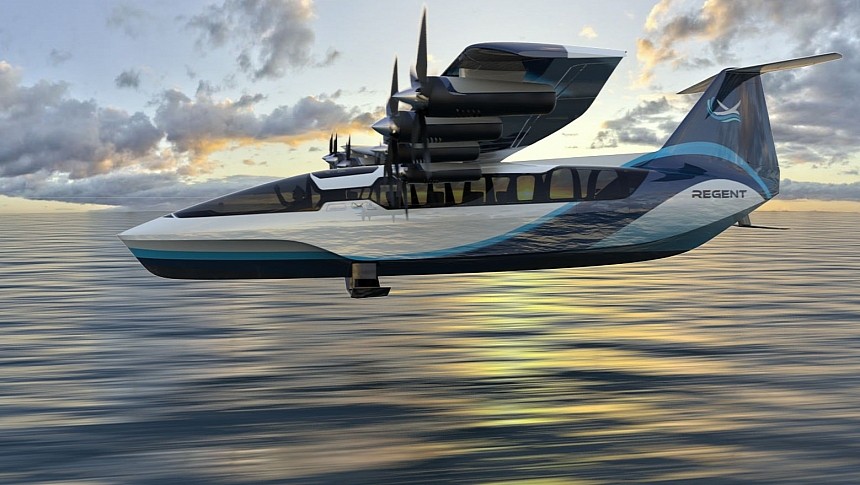While the US Air Force is already making history with the first eVTOLs (electric vertical takeoff and landing) stationed at a military base, the US Marine Corps is looking into equally innovative alternatives linked to mobility in the littorals. The Viceory seaglider is up for the part.
We mostly hear about seagliders in connection to island hopping, tourism, and resort transportation. These aircraft that operate close to the water's surface bring vacations, travel, and beautiful coastal cities to mind. Yet, they can also play a pivotal role in defense logistics. This is why the US Marine Corps didn't hesitate to pump nearly $5 million into a Rhode Island-based seaglider developer.
Regent Craft, the manufacturer of the Viceroy seaglider, secured a $4.5 million deal with the Marine Corps Warfighting Lab (MCWL). The two are launching a program where the Viceroy will get to show what it can do, from its three modes of operation to maneuver and transport operations. In other words, Regent Craft will demonstrate the seaglider technology for defense logistics applications.
The Marines could operate this seaglider in the littorals, with multiple roles, including troop and cargo transport, ISR (intelligence, surveillance, and reconnaissance), and expeditionary advanced base operations.
What sets it apart from other air vehicles is that it doesn't require runway infrastructure, it has a low signature, and it promises low-cost operations. In terms of performance, Viceroy combines high payload (it can carry 12 passengers of 3,500 lbs/1,587 kg of cargo) with high speed and a long range (180 miles/289 km per charge).
Viceroy, Regent Craft's seaglider, is officially classed as a wing-in-ground effect craft. It claims to combine an airplane's high speed with a boat's operational low costs. As a 100% electric aircraft, it offers the benefits of zero-emission, ultra-low-altitude transportation.
Unlike conventional aircraft, it doesn't require runways and is compatible with the existing dock infrastructure. In the future, as battery technology continues to evolve, it's expected to extend its zero-emission range to 500 miles (800 km).
In addition to the battery propulsion system, what sets apart this futuristic machine from other seagliders is the hydrofoil technology, adapted from maritime design. It claims to be the first of its kind to combine wing-borne flight with hydrofoil wave-tolerance.
The Viceroy seaglider boasts three modes of operation: hull, foil, and wing-borne. It takes off from the dock like a boat; as it speeds up, it rises on its hydrofoil for a smooth transition to the wing-borne mode, when it flies like an airplane at just a few meters above the water's surface.
The Rhode Island company will conduct a live technical demonstration of its full-scale prototype at the end of this exciting program with the US Marine Corps. The demonstration will take place during a large-scale military exercise.
Regent Craft, the manufacturer of the Viceroy seaglider, secured a $4.5 million deal with the Marine Corps Warfighting Lab (MCWL). The two are launching a program where the Viceroy will get to show what it can do, from its three modes of operation to maneuver and transport operations. In other words, Regent Craft will demonstrate the seaglider technology for defense logistics applications.
The Marines could operate this seaglider in the littorals, with multiple roles, including troop and cargo transport, ISR (intelligence, surveillance, and reconnaissance), and expeditionary advanced base operations.
What sets it apart from other air vehicles is that it doesn't require runway infrastructure, it has a low signature, and it promises low-cost operations. In terms of performance, Viceroy combines high payload (it can carry 12 passengers of 3,500 lbs/1,587 kg of cargo) with high speed and a long range (180 miles/289 km per charge).
Viceroy, Regent Craft's seaglider, is officially classed as a wing-in-ground effect craft. It claims to combine an airplane's high speed with a boat's operational low costs. As a 100% electric aircraft, it offers the benefits of zero-emission, ultra-low-altitude transportation.
Unlike conventional aircraft, it doesn't require runways and is compatible with the existing dock infrastructure. In the future, as battery technology continues to evolve, it's expected to extend its zero-emission range to 500 miles (800 km).
In addition to the battery propulsion system, what sets apart this futuristic machine from other seagliders is the hydrofoil technology, adapted from maritime design. It claims to be the first of its kind to combine wing-borne flight with hydrofoil wave-tolerance.
The Viceroy seaglider boasts three modes of operation: hull, foil, and wing-borne. It takes off from the dock like a boat; as it speeds up, it rises on its hydrofoil for a smooth transition to the wing-borne mode, when it flies like an airplane at just a few meters above the water's surface.
The Rhode Island company will conduct a live technical demonstration of its full-scale prototype at the end of this exciting program with the US Marine Corps. The demonstration will take place during a large-scale military exercise.










